
|
stearic acid |
stearic acid is a lipid of Fatty Acyls (FA) class. Stearic acid is associated with abnormalities such as Helminthiasis, Exanthema, Chronic disease, Obesity and Dyslipidemias. The involved functions are known as acyltransferase activity, Mutation, Cell division, cell fate and Fatty Acid Metabolism. Stearic acid often locates in membrane fraction, Mouse Liver, Membrane, Body tissue and Endoplasmic reticulum, membrane. The associated genes with stearic acid are Homologous Gene, ACLY gene, Transgenes, FATE1 gene and Alleles. The related lipids are Lysophospholipids, Stearic acid, Fatty Acids, cis-vaccenic acid and Phosphatidylserines. The related experimental models are Knock-out. |
5692 |

|
Arachidonic acid |
Arachidonic acid is a lipid of Fatty Acyls (FA) class. Arachidonic acid is associated with abnormalities such as Atherosclerosis, Ischemia, Hypertensive disease, Hypertension induced by pregnancy and Vascular ring of aorta. The involved functions are known as Platelet aggregation, Anabolism, Ion Transport, Signal Transduction Pathways and Signal. Arachidonic acid often locates in Extracellular, Body tissue, Protoplasm, Tissue membrane and soluble. The associated genes with Arachidonic acid are CYP2J2 gene, CYP2E1 gene, Recombinant Proteins, POR gene and P4HTM gene. The related lipids are Fatty Acids, Glycerophospholipids, Steroids, octadecadienoic acid and 9-hydroxy-10,12-octadecadienoic acid. The related experimental models are Mouse Model and Knock-out. |
22864 |

|
DHA |
Dha is a lipid of Fatty Acyls (FA) class. Dha is associated with abnormalities such as Atherosclerosis, Consumption-archaic term for TB, Chronic disease, Cardiovascular Diseases and Diabetes Mellitus, Non-Insulin-Dependent. The involved functions are known as Inflammation, Oxidation, fatty acid oxidation, Fatty Acid Metabolism and Lipid Metabolism. Dha often locates in Hepatic, Protoplasm, Mucous Membrane, Epithelium and outer membrane. The associated genes with DHA are IMPACT gene, FATE1 gene, GAPDH gene, THOC4 gene and SLC33A1 gene. The related lipids are stearidonic acid, Fatty Acids, Total cholesterol, Lipopolysaccharides and Dietary Fatty Acid. The related experimental models are Mouse Model, Transgenic Model, Animal Disease Models and Arthritis, Experimental. |
11054 |

|
4-hydroxynonenal |
4-hydroxynonenal is a lipid of Fatty Acyls (FA) class. 4-hydroxynonenal is associated with abnormalities such as Chronic disease, Obesity, Diabetes, Acquired Immunodeficiency Syndrome and Lung diseases. The involved functions are known as protein expression, Glycolysis, mRNA Expression, Regulation and Mitochondrion in division. 4-hydroxynonenal often locates in Muscle, Mitochondria, Adipose tissue, Head and Mouse Muscle. The associated genes with 4-hydroxynonenal are STAT3 gene, SIRT1 gene, PGC gene, IL6 gene and cytochrome c''. The related lipids are Lipopolysaccharides, Lipid Peroxides, Promega, Membrane Lipids and oxidized lipid. The related experimental models are Mouse Model, Knock-out, Transgenic Model, Disease model and Rodent Model. |
5685 |

|
7-octadecynoic acid |
7-octadecynoic acid is a lipid of Fatty Acyls (FA) class. |
8379 |

|
(r)-3-hydroxybutanoic acid |
(r)-3-hydroxybutanoic acid is a lipid of Fatty Acyls (FA) class. |
2710 |

|
Pyruvic acid |
Pyruvic acid is a lipid of Fatty Acyls (FA) class. |
27047 |
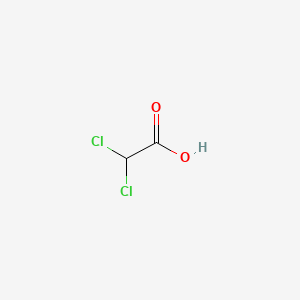
|
Dichloroacetic acid |
Dichloroacetic acid is a lipid of Fatty Acyls (FA) class. Dichloroacetic acid is associated with abnormalities such as Acidosis, Lactic, Metabolic Diseases, CLEFT LIP, CONGENITAL HEALED, Asthma and hyperthyroid. The involved functions are known as inhibitors, Chlorination, Metabolic Inhibition, Process and Sterility. Dichloroacetic acid often locates in Intestine - Large Intestine - Cecum (MMHCC), Mouse Liver, Back and Head. The associated genes with Dichloroacetic acid are GSTZ1 gene, PSMA5 gene and Maleylacetoacetate isomerase. The related lipids are Nonesterified Fatty Acids. |
2361 |

|
4-aminobutyric acid |
4-aminobutyric acid is a lipid of Fatty Acyls (FA) class. 4-aminobutyric acid is associated with abnormalities such as Epilepsy and Premenstrual syndrome. The involved functions are known as Binding (Molecular Function), neuron survival, Process, Uptake and physiological aspects. 4-aminobutyric acid often locates in Microglial, Neurofilament, Neuraxis, Brain region and Neurites. The associated genes with 4-aminobutyric acid are arginine methyl ester, SLC33A1 gene, NKS1 gene, P4HTM gene and ITSN2 gene. The related lipids are pregnenolone sulfate, pregnane-20-one, Pregnanes, Steroids and endogenous steroids. |
19702 |

|
2,5-diaminopentanoic acid |
2,5-diaminopentanoic acid is a lipid of Fatty Acyls (FA) class. The involved functions are known as Vasodilation, Intestinal Absorption and Pinocytosis. 2,5-diaminopentanoic acid often locates in Mitochondria, Microfilaments, NADH dehydrogenase complex and respiratory chain complex III location sensu Eukarya. The associated genes with 2,5-diaminopentanoic acid are GAPDH gene and iberiotoxin. |
8868 |

|
Lipoic acid |
Lipoic acid is a lipid of Fatty Acyls (FA) class. |
7940 |

|
11beta-PGF2 |
11beta-pgf2 is a lipid of Fatty Acyls (FA) class. |
15009 |

|
Leukotriene b4 |
Leukotriene b4 is a lipid of Fatty Acyls (FA) class. The involved functions are known as Chemotaxis, release of sequestered calcium ion into cytoplasm and Polymerization. Leukotriene b4 often locates in Protoplasm. The associated genes with Leukotriene b4 are phallacidin. |
9311 |
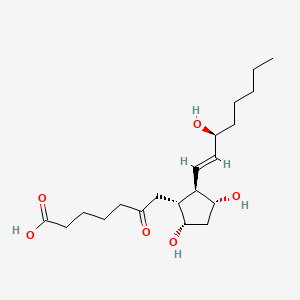
|
6-keto-pgf1alpha |
6-keto-pgf1alpha is a lipid of Fatty Acyls (FA) class. |
3430 |
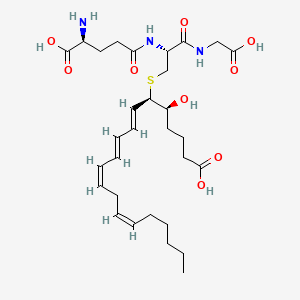
|
LTC4 |
Ltc4 is a lipid of Fatty Acyls (FA) class. Ltc4 is associated with abnormalities such as Asthma, Eosinophilia, Pulmonary Eosinophilia, Pneumonia and Cardiovascular Diseases. The involved functions are known as Signal, Gene Expression, Stimulus, Signal Transduction and Metabolic Inhibition. Ltc4 often locates in Plasma membrane, Cytoplasm, Back, Cytoplasmic and Tissue membrane. The associated genes with LTC4 are STIM1 gene, ABCC2 gene, CD9 gene, Mutant Proteins and Amino Acids, Aromatic. The related lipids are glycolithocholate. |
2252 |
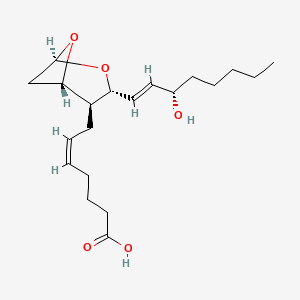
|
Thromboxane a2 |
Thromboxane a2 is a lipid of Fatty Acyls (FA) class. Thromboxane a2 is associated with abnormalities such as Asthma, Cardiovascular Diseases, Pulmonary Eosinophilia, ASPIRIN SENSITIVITY and Pneumonia. The involved functions are known as Signal Transduction, paracrine, Binding (Molecular Function), Platelet Activation and Inflammation. Thromboxane a2 often locates in Cell surface, Body tissue, Cell membrane, Blood and Extracellular. The associated genes with Thromboxane a2 are PTPRC gene, ESAM gene and PPBP gene. |
4534 |

|
Thromboxane b2 |
Thromboxane b2 is a lipid of Fatty Acyls (FA) class. Thromboxane b2 is associated with abnormalities such as endothelial dysfunction, Diabetes Mellitus, Non-Insulin-Dependent, Diabetes Mellitus, Ischemia and Thrombocytosis. The involved functions are known as Platelet Activation, Excretory function, Anabolism, Inflammation and mRNA Expression. Thromboxane b2 often locates in Endothelium, Hepatic and Microsomes, Liver. The associated genes with Thromboxane b2 are PTGS2 gene, prothrombin fragment 2 and CCL14 wt Allele. |
10175 |

|
Anandamide |
Anandamide is a lipid of Fatty Acyls (FA) class. Anandamide is associated with abnormalities such as Dehydration. The involved functions are known as Process, Phenomenon, Phosphorylation, Catabolic Process and Gene Expression. Anandamide often locates in Nuchal region, Microglial and Hepatic. The associated genes with Anandamide are SGPL1 gene, SPTLC1 gene, RPSA gene, KDSR gene and SMPD1 gene. The related lipids are Sphingolipids, Lipopolysaccharides, Lysophospholipids, LYSO-PC and lysophosphatidylethanolamine. |
4747 |
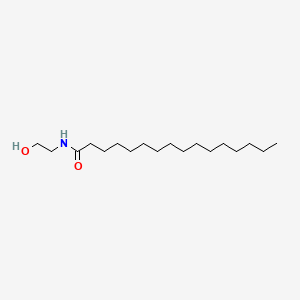
|
Palmitoyl-EA |
Palmitoyl-ea is a lipid of Fatty Acyls (FA) class. The involved functions are known as Cytokinesis of the fertilized ovum and phosphatase activity. The related lipids are stearic acid. |
1001 |
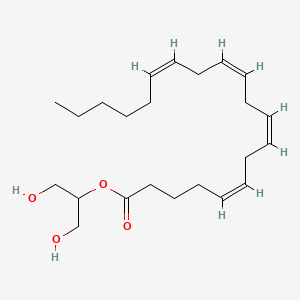
|
2-arachidonoylglycerol |
2-arachidonoylglycerol is a lipid of Glycerolipids (GL) class. 2-arachidonoylglycerol is associated with abnormalities such as Atherosclerosis, Heart Diseases, Inflammatory disorder, Colitis and Peripheral Neuropathy. The involved functions are known as Immunoreactivity, inhibitors, Stimulus, Esthesia and Signal Transduction. 2-arachidonoylglycerol often locates in Back, Presynaptic Terminals, Brain region, Blood and Body tissue. The associated genes with 2-arachidonoylglycerol are ADRBK1 gene, Homologous Gene, MGLL gene, PLA2G4A gene and peptide V. The related lipids are oleoylethanolamide, Lipopolysaccharides, Promega, stearic acid and 1-stearoyl-2-arachidonoylglycerol. The related experimental models are Knock-out. |
1892 |

|
Platelet activating factor |
Platelet activating factor is a lipid of Glycerophospholipids (GP) class. Platelet activating factor is associated with abnormalities such as Atherosclerosis, Acute cholecystitis without calculus, Cholecystitis, Colitis and Cholecystitis, Acute. The involved functions are known as Cell Survival, Metabolic Inhibition, lipid oxidation, Apoptosis and Oxidation. Platelet activating factor often locates in soluble, Cellular Membrane, Smooth muscle (tissue), Intima and Tissue specimen. The associated genes with Platelet activating factor are apolipoprotein A-I Milano, Homologous Gene, TSPO gene, HBEGF gene and SLC33A1 gene. The related lipids are Hydroxycholesterols, Liposomes, 25-hydroxycholesterol, Lysophosphatidylcholines and Lipopolysaccharides. The related experimental models are Knock-out, Mouse Model and Transgenic Model. |
7383 |

|
tacrolimus |
Tacrolimus is a lipid of Polyketides (PK) class. Tacrolimus is associated with abnormalities such as Renal glomerular disease. The involved functions are known as inhibitors, Fungicidal activity, Metabolic Inhibition, Excretory function and Dephosphorylation. Tacrolimus often locates in Hepatic, Mitochondrial matrix and Inner mitochondrial membrane. The associated genes with Tacrolimus are RHOA gene and BGN gene. |
12730 |

|
minocycline |
minocycline is a lipid of Polyketides (PK) class. Minocycline is associated with abnormalities such as Infection, Soft Tissue Infections, Septicemia, Chronic hyponatremia and Lesion of brain. The involved functions are known as Pharmacodynamics, Gene Expression, Transcriptional Activation, Regulation and Process. Minocycline often locates in Ribosomes, 50S ribosomal subunit, Blood, Skin and Immune system. The associated genes with minocycline are THEMIS gene, KCNK2 gene, RBFOX3 gene, PIWIL2 gene and P4HTM gene. The related lipids are Lipopolysaccharides, Promega, Steroids, Liposomes and Octanols. The related experimental models are Mouse Model, Experimental Autoimmune Encephalomyelitis, Genetically Engineered Mouse, Disease model and spinal model. |
9780 |

|
oxytetracycline |
oxytetracycline is a lipid of Polyketides (PK) class. Oxytetracycline is associated with abnormalities such as Infection, X-linked centronuclear myopathy, Bacterial Infections, Heart failure and Onchocerciasis. The involved functions are known as Anabolism, physiological aspects, Transcription, Genetic, Fermentation and Transcriptional Activation. Oxytetracycline often locates in Chromosomes, Flank (surface region), Entire bony skeleton, Bone Marrow and Body tissue. The associated genes with oxytetracycline are Polypeptides, Homologous Gene, Gene Clusters, Locus and CYCS gene. The related lipids are LH 1 and Lipid Peroxides. The related experimental models are Disease model. |
6787 |

|
(-)-Epigallocatechin gallate |
(-)-Epigallocatechin gallate is a lipid of Polyketides (PK) class. (-)-epigallocatechin gallate is associated with abnormalities such as IMMUNE SUPPRESSION, Infection, Nodule, Lymphopenia and Tumor Immunity. The involved functions are known as Apoptosis, Cellular Immune Response, Specific immune response, Signal and Infiltration. (-)-epigallocatechin gallate often locates in Immune system, Cytoplasmic Granules, Skin, Protoplasm and Body tissue. The associated genes with (-)-Epigallocatechin gallate are C8orf4 gene, Genes, vpr, MAPK8 gene, P4HTM gene and GAG Gene. The related lipids are Promega, Lipopolysaccharides, Palmitates, Fatty Acids and Sphingolipids. The related experimental models are Mouse Model, Xenograft Model, Transgenic Model, Experimental Autoimmune Encephalomyelitis and Arthritis, Collagen-Induced. |
6551 |

|
rotenone |
rotenone is a lipid of Polyketides (PK) class. Rotenone is associated with abnormalities such as Parkinson Disease, MYOPATHY, DISTAL, WITH ANTERIOR TIBIAL ONSET, Neurodegenerative Disorders, Septicemia and Respiratory Failure. The involved functions are known as Phosphorylation, Process, Cell Death, proteasome activity and Apoptosis. Rotenone often locates in Protoplasm, Presynaptic Terminals, Neurites, NADH dehydrogenase complex and Mitochondria. The associated genes with rotenone are DNAJB9 gene, EIF2S3 gene, Candidate Disease Gene, G-substrate and ERN1 gene. The related lipids are Lipopolysaccharides, Membrane Lipids, Phosphatidylserines, Fatty Acids and Cardiolipins. The related experimental models are Knock-out, Mouse Model, Disease model and Rodent Model. |
7079 |

|
quercetin |
quercetin is a lipid of Polyketides (PK) class. Quercetin is associated with abnormalities such as Coronary heart disease, Myocardial Infarction, Cirrhosis, Coronary Arteriosclerosis and Vascular ring. The involved functions are known as Vasodilation, physiological aspects, Fermentation, Process and Ingredient. Quercetin often locates in Arterial system, Endothelium, Skin, Endothelium, Vascular and Tissue specimen. The associated genes with quercetin are P4HTM gene, SULT gene, UGT1A1 gene, ARHGAP26 gene and PLXNB1 gene. The related lipids are blood lipid, Promega, Steroids, Phosphatidylserines and Fatty Acids. The related experimental models are Knock-out, Mouse Model, Xenograft Model, Tissue Model and Cancer Model. |
5377 |

|
apigenin |
apigenin is a lipid of Polyketides (PK) class. Apigenin is associated with abnormalities such as Morphologically altered structure, Chimera disorder, Hypertensive disease, infection induced and Infection. The involved functions are known as inhibitors, Gene Expression, Process, Metabolic Inhibition and Cell Death. Apigenin often locates in Vacuole, Cytoplasmic matrix, Cytoplasm, Tissue membrane and Membrane. The associated genes with apigenin are MSMP gene, BCL2 gene, PTGS2 gene, Chromatin and SLC33A1 gene. The related lipids are Lipopolysaccharides, Steroids, 1-Butanol, agosterol A and Butyrates. The related experimental models are Mouse Model, Tissue Model, Knock-out, Xenograft Model and Disease model. |
4250 |
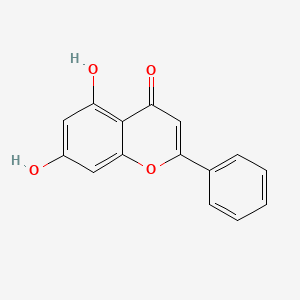
|
chrysin |
chrysin is a lipid of Polyketides (PK) class. Chrysin is associated with abnormalities such as Unconjugated hyperbilirubinemia, Metabolic Diseases, Hypogonadism, Renal tubular disorder and Colitis. The involved functions are known as Hypoxia, enzyme activity, Oxidation, inhibitors and Cell Survival. Chrysin often locates in Protoplasm, Plasma membrane, Back, Extracellular and Mitochondria. The associated genes with chrysin are CFB gene, P4HTM gene, UGT1A9 gene, CYP1A1 gene and UGT1A1 gene. The related lipids are Promega, estradiol-3-glucuronide, Steroids and Lipopolysaccharides. The related experimental models are Mouse Model. |
1085 |

|
butein |
Butein is a lipid of Polyketides (PK) class. Butein is associated with abnormalities such as Glomerulonephritis, Fibrosis, Liver, Kidney Failure, Acute, Mastocytosis and Chimera disorder. The involved functions are known as Phosphorylation, Transcription, Genetic, IkappaB kinase activity, Gene Expression and Signal Transduction. Butein often locates in Membrane, Cytoplasmic, IkappaB kinase complex, Protoplasm and Plasma membrane. The associated genes with Butein are ICAM1 gene, MAPK8 gene, MYC gene, BCL2 gene and BCL2L1 gene. The related lipids are Promega. The related experimental models are Xenograft Model, Knock-out and Mouse Model. |
190 |

|
Thapsigargin |
Thapsigargin is a lipid of Prenol Lipids (PR) class. Thapsigargin is associated with abnormalities such as Impaired glucose tolerance, Obesity and Blood Pressure Disorders. The involved functions are known as Phosphorylation, establishment and maintenance of localization, Regulation, Metabolic Inhibition and Proteolysis. Thapsigargin often locates in Mouse Skin, Cytoplasm, Skin, Protoplasm and Mitochondria. The associated genes with Thapsigargin are ERBB4 gene, F11 gene, CA1 gene, TRNAP1 gene and HSPA5 gene. The related lipids are taurolithocholic acid 3-sulfate, Liposomes, Fatty Acids and stearylamine. The related experimental models are Mouse Model. |
8868 |

|
forskolin |
Forskolin is a lipid of Prenol Lipids (PR) class. Forskolin is associated with abnormalities such as Cholestasis, Vocal cord dysfunction familial, Hypothyroidism, Renal tubular disorder and Disintegration (morphologic abnormality). The involved functions are known as Cell Proliferation, Anabolism, mRNA Expression, Agent and Signal. Forskolin often locates in Extracellular, Body tissue, Skin, Tissue membrane and Membrane. The associated genes with forskolin are P4HTM gene, SLC33A1 gene, NR1I2 gene, Genes, Reporter and CYP3A gene. The related lipids are Steroids, steroid sulfate, Fatty Acids, LYSO-PC and Lipopolysaccharides. |
24755 |
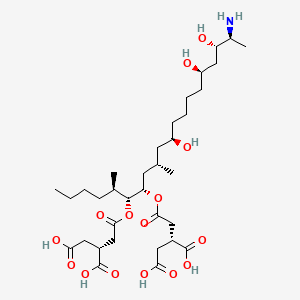
|
fumonisin b1 |
fumonisin b1 is a lipid of Sphingolipids (SP) class. Fumonisin b1 is associated with abnormalities such as Infection, Kidney Diseases, Liver diseases, DERMATITIS HERPETIFORMIS, FAMILIAL and Malnutrition. The involved functions are known as Gene Expression, Anabolism, Signal, Biosynthetic Pathways and Regulation. Fumonisin b1 often locates in Body tissue, Microsomes, microsomal membrane, Protoplasm and Mitochondria. The associated genes with fumonisin b1 are Genome, P4HTM gene, FATE1 gene, BCL2 gene and TMEM132D gene. The related lipids are dihydroceramide, ceramide 1-phosphate, Sphingolipids, Fatty Acids and Palmitates. |
902 |

|
cholesterol |
cholesterol is a lipid of Sterol Lipids (ST) class. Cholesterol is associated with abnormalities such as Trypanosomiasis, Chagas Disease, Cleft Palate, Chondrodysplasia punctata 2, X-linked dominant and Child syndrome. The involved functions are known as Blood Circulation, Sterol Biosynthesis Pathway, Receptor Mediated Endocytosis, Methylation and Signal. Cholesterol often locates in Animal tissue, Blood, Membrane, Plasma membrane and peroxisome. The associated genes with cholesterol are MBD2 gene, SIM, SLC33A1 gene, Genome and NSDHL gene. The related lipids are Sterols, zymosterol, fecosterol, Total cholesterol and 7-dehydrocholesterol. The related experimental models are Mouse Model, Knock-out, Genetically Engineered Mouse and Disease model. |
98461 |

































